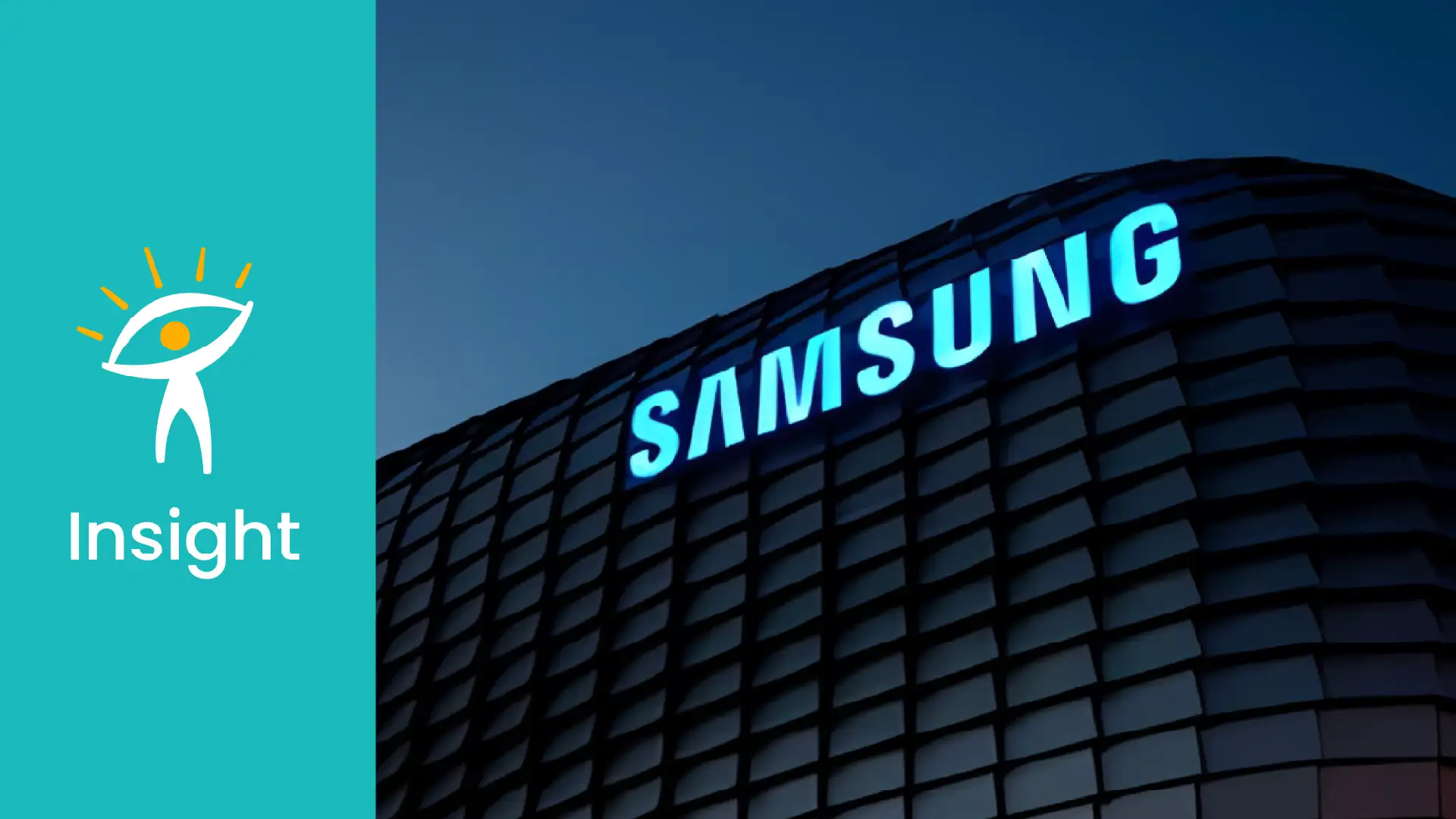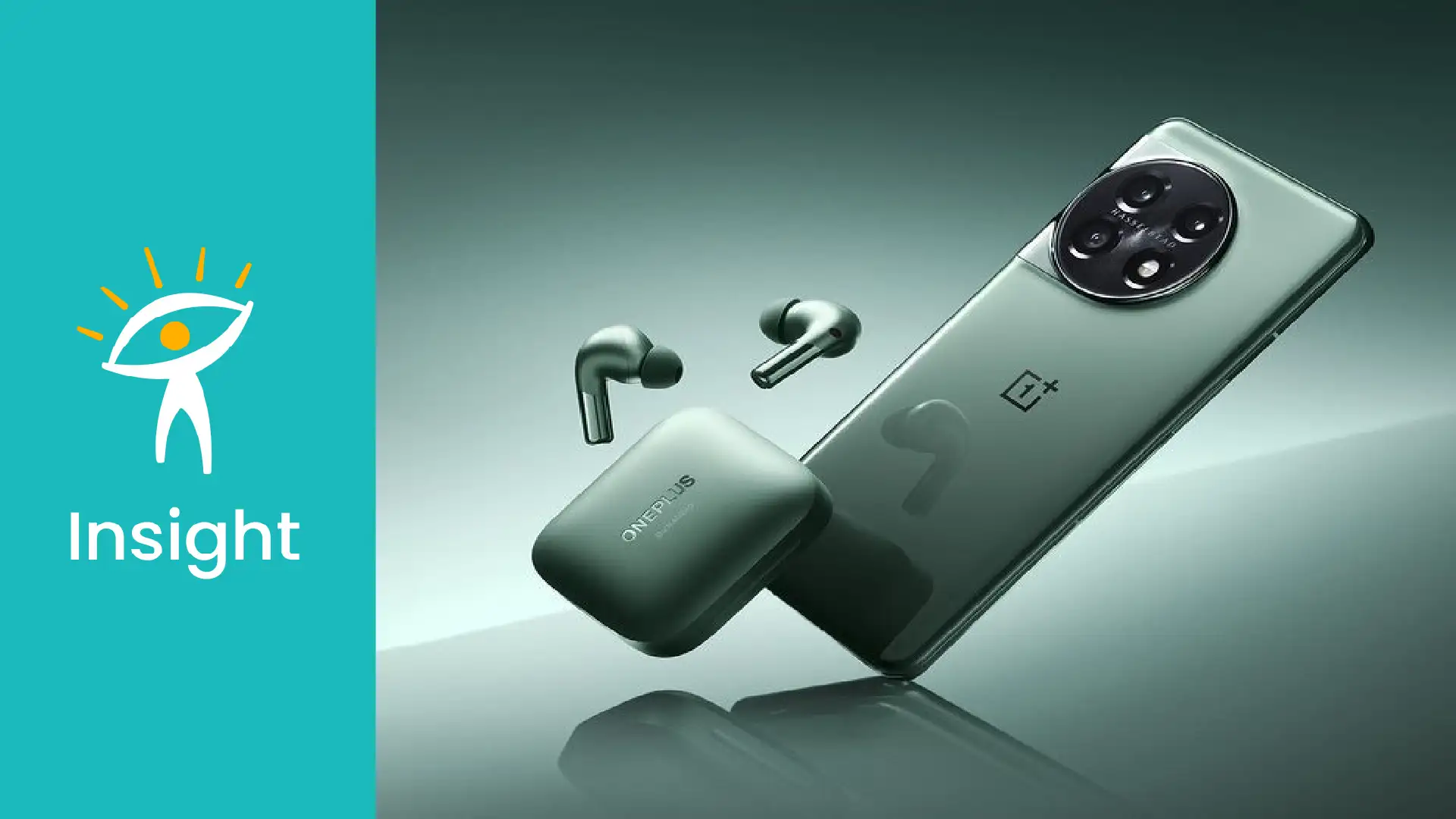Samsung, a name synonymous with innovation, has established itself as a global leader in the technology sector. Founded in South Korea in 1938, from its primitive stage as a trading company, it has grown into a corporation covering several lines of businesses, including electronics, semiconductors, telecommunications, and home appliances.
Particularly, this enterprise is recognized in the context of the production of the most advanced smartphones, televisions, and home appliances, which long since have formed the name of this company common in every household across the globe.
With its presence in over 80 counties and more than 300,000 employees on its staff, it is evident that no exact market sector is untouched by Samsung.
This article explores Samsung’s expansive business ecosystem and the strategies that have established it as a leader in the technology industry. Examining Samsung’s customer service approach, innovative technology use, and adaptability to market demands, provides insights into what makes Samsung a dominant global force. This analysis highlights how Samsung leverages its technological capabilities to sustain its leadership and drive future success.
1. Samsung’s Corporate History
Samsung was initiated in 1938 by Lee Byung-chul as a small trading company based in Su-dong, Korea. The company’s first activity was confined to the export of dried fish, locally-grown groceries, and noodles. Source.
In 1969 Samsung Electronics was launched, which was a significant step as it introduced the corporation to the electronics sector, revolutionizing the entire company’s future.
As early as the 1980s, Samsung was recognized on a global scale, with the pivotal year of the corporation’s history being 1983: this was the year when the world saw for the first time Samsung’s revolutionary 64K DRAM chip, which marked this enterprise as a substantial technology contributor.
This product laid the background for Samsung’s further occupation of a firm position in the electronics manufacturing sector with the next big move in home appliances, mobile phones, and TV manufacturing. Source.
The motto of the late Chairman of Samsung Lee Kun-hee, “Change everything except your wife and children,” encapsulates the approach to the ever-adapting previously set by Samsung.
Key Milestones in Samsung’s Journey

Samsung Electronics Global Revenue 2023 (Image Source: Statistica)
Several essential milestones mark Samsung’s transformation into a global electronics giant. In 1992 the company became the undisputed leader of memory chip manufacturing, a title, it continues to hold. Source.
The novelty factor that most greatly influenced the mobile phone sector, was the initiation of the first mobile phone, which appeared in 1988. Source. Yet, it was the 2010 launch of the GALAXY S that gave the sector enormous effect.
Correspondingly, in 2011 Samsung released the first world’s smart refrigerator. The switch from a regional trading company to a global technology innovator in the Samsung experience is a homage to the commitment to producing only the highest quality.
As of 2023, Samsung has reported revenues of $259 trillion, the official acknowledgment of the leading position in the electronics sector. Source.
2. Samsung’s Business Ecosystem
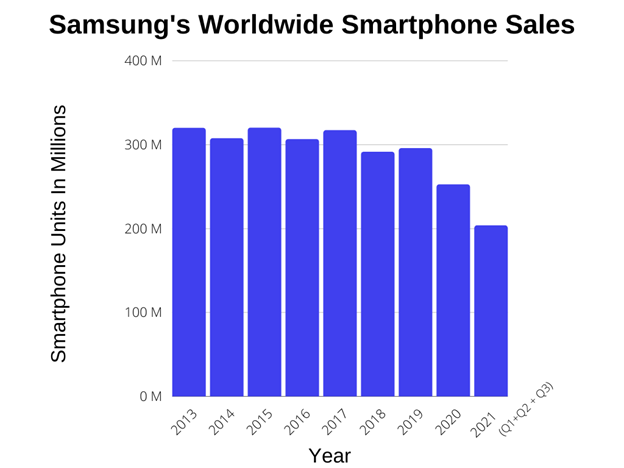
(Image Source: Mirromeister)
Samsung’s business ecosystem is extensive and diverse, reflecting its growth and development into a global multi-faceted conglomerate. The firm’s product offering spans multiple industries, and it plays a leading role in both technology and consumer electronics.
Smart Phones
Samsung has consistently offered a range of consumer electronics devices, with one of its key products being its smartphone. In 2024, the company was the world’s top smartphone maker by sales, dominating 20% of the total market, and catering to both the high-end and affordable market segments. Source.
Home Appliances
The company has held the title of the world’s largest TV manufacturer for over 15 years, thanks to its commitment to innovation in display technology, including QLED and OLED displays.
Samsung also manufactures a variety of other home appliances, such as refrigerators, washers, and air conditioners. As part of the company’s commitment to change and improvement, it offers smart home products that integrate its systems, using principles of Artificial Intelligence AI, as well as the Internet of Things IoT, to coordinate and maintain appliances in a consumer’s home. Source.
Semi-Conductors
The company’s most notable achievement, however, comes in the form of semiconductors, whereby in 2022, the company was the global market leader, posting $63.8 billion in semiconductor sales. This extensive product portfolio not only demonstrates Samsung’s market reach but also its ability to innovate across various technology sectors. Source.
Market Leadership
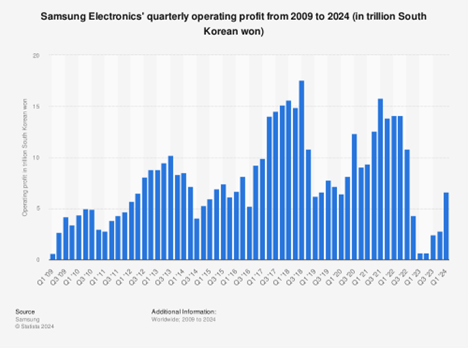
(Image Source: Statista)
The critical role in the company’s success is highlighted by the fact that in 2023, for example, the organization spent approximately $21 billion in R&D. Source.
The company has managed to successfully penetrate other developing markets such as Africa and Asia. Furthermore, it has also managed to advance the state of display technology through the development of QLED displays and the more recent MicroLED displays.
Finally, Samsung has taken a proactive role in reducing and offsetting its carbon emissions, having recently undertaken a series of steps towards its 2050 zero net carbon emissions agenda.
3. Customer Service Philosophy at Samsung

(Image Source: Samsung Support)
Lee Byung-chul, the founder of Samsung, once said, “A company is its people. A company can only grow if its people grow.” This philosophy extends to Samsung’s approach to customer service, where the focus is on delivering quality products and fostering strong relationships with customers.
Samsung employs various strategies to ensure quality and responsiveness:
- Voice of Customer (VOC) Management: Samsung actively listens to its customers through surveys, interviews, and periodic quality reviews. This feedback loop allows the company to drive sustainable quality innovations and address customer needs effectively. Source
- Claim Management: The company has established a systematic approach to handling quality claims. This includes analyzing customer dissatisfaction, devising countermeasures, and taking corrective actions to prevent recurrence of issues. By doing so, Samsung ensures that quality concerns are addressed promptly, enhancing customer trust.
- Return Material Authorization (RMA): This process allows Samsung to quickly identify and resolve quality issues with products that have already been shipped. The goal is to minimize customer disruptions and maintain high standards of service.
Samsung’s Online and Offline Customer Service Integration
This integration allows customers to access a range of support options and transition smoothly between them:
Online Support Resources
- Samsun’s online support platform must cater to a trove of troubleshooting guides, software updates, service FAQs, and even live chat support options. There are many tools available that let you take care of several problems without having to touch a person.
Offline Service Centers
- Local availability of face-to-face technical help provided by Samsung in its vast network across the country. These centers can be visited for repairs, device evaluations, and other technical services.
Online Appointment Scheduling
- Customers can also schedule service appointments online, choosing an available time and location at their preferred Service Center. This cuts the wait time and improves overall service adequacy.
Customer Profiles
- Having detailed customer profiles that get updated after every interaction. These profiles will include purchase history, service requests, and previous interactions with support. This data is easily accessible to online or offline support teams who will be able to offer personalized and well-informed help.
Real-Time Data Syncing
- Real-time data syncing enables updates to be reflected in offline systems as soon as they are made online and the other way around. For example, if a customer schedules an appointment for service online those details are immediately accessible to in-store staff so that they can help reduce wait times and provide more convenient interactions.
Global Reach of Samsung’s Support
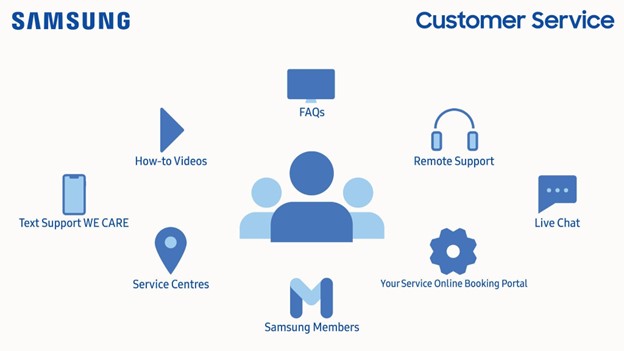
Samsung’s customer service is designed to cater to a global audience, ensuring that customers in every market receive the same level of support. With more than 11,000 service centers in 180 countries, the Samsung support network is one of the most impressive in the tech industry. Source.
For instance, in the United States, Samsung support has shifted toward online resources, offering troubleshooting guides, software updates, and live chat to tech-savvy U.S. customers. Source.
Meanwhile, in regions like Southeast Asia, where in-person service remains crucial, and for that reason, Samsung has increased the number of real-world locations over the years.
The company has increased the number of such centers as much as possible in remote areas so that every client can access high-quality service as quickly as possible. Source.
Samsung further developed its position in Europe by providing a mobile repair service that was launched for customers’ convenience. Technicians can repair devices such as smartphones and tablets, which may take no more than an hour, wherever the customer is – at home at a company. Source.
During the COVID-19 pandemic, Samsung demonstrated its ability to adapt to local conditions by launching a doorstep repair service.
The technology allowed customers to repair without leaving their homes, which is especially relevant during lockdowns. This experience proves that Samscane to maintain its tailored support for various markets. Source.
In Europe, the company also expanded its services and, in response to customer feedback, introduced extended warranties for up to 5 years for premium home appliances, which were especially popular in Germany and the UK. Source. Such examples confirm that Samsung is constantly improving its service based on customer feedback.
Samsung’s Integration with Amazon: A Synergistic Approach to E-Commerce and Smart Technology
One of the most prominent aspects of Samsung’s integration with Amazon is the availability of Samsung products on Amazon’s marketplace. This partnership allows Samsung to tap into Amazon’s extensive customer base, providing a seamless purchasing experience for consumers.
Another significant advancement in Samsung’s integration with Amazon is their collaboration on the Matter protocol, an open-source standard designed to enhance the compatibility and interoperability of smart home devices. Samsung’s integration with Matter ensures that over 150 devices across multiple brands can now work seamlessly with Amazon’s Alexa. Samsung News
Advancements in Virtualized RAN Networks with AWS
Samsung has partnered with Amazon Web Services (AWS) to drive innovation in virtualized Radio Access Networks (vRAN) on the public cloud. This collaboration focuses on leveraging AWS’s cloud capabilities to enhance the efficiency and scalability of Samsung’s telecommunications solutions. This integration enables network operators to achieve a 25% reduction in operational costs and a 30% increase in deployment speed.
According to a blog post by AWS, this collaboration is “transforming the way network operators deploy and manage their networks, enabling faster innovation and more efficient operations.” Source.
Streamline Customer Support:
Dedicated Support Channels
- Samsung offers dedicated support resources through Amazon’s platform for users who have purchased Samsung products. This includes access to troubleshooting guides, FAQs, and direct support channels that facilitate quicker resolutions for common issues.
Enhanced Warranty Services
- Samsung has integrated its warranty management system with Amazon, allowing users to easily file warranty claims and track their service status through their Amazon account.
Efficient Issue Resolution
- The partnership has introduced features such as one-click support options for Samsung products purchased on Amazon. This integration simplifies the process of contacting support, reducing wait times and improving overall customer satisfaction.
Samsung and Microsoft: A Seamless Integration for Enhanced Productivity
According to CCS Insight, 42% of employees spend over three hours a day working on mobile devices, with this figure rising to 51% among millennial workers. This partnership facilitates a seamless, unified experience across various devices, regardless of the user’s location. Source.
Enhanced Productivity Through Outlook Integration:
Samsung’s integration with Microsoft Outlook on the Galaxy Note 10 has optimized productivity by consolidating email, calendar, contacts, and files into a single application. This seamless integration allows users to efficiently manage their professional and personal communications. Source.
Unified Cloud Storage with OneDrive:
The new synchronization feature between Samsung Gallery and Microsoft OneDrive simplifies how users handle their media. Starting this fall, users will be able to sync their photos and videos across devices effortlessly.
Streamlined Communication and Collaboration:
The partnership also supports businesses by ensuring a unified experience across Windows 11 and Samsung devices. Integration with Microsoft Teams, SharePoint, and OneDrive facilitates collaboration for remote and hybrid teams. The use of Samsung’s Video Call for Microsoft Teams on Galaxy devices further enhances virtual meetings, making it easier to organize and participate in video conferences. Source
4. Technology and Innovation at Samsung

(Image Source: Samsung Customer Service)
Omnichannel Support System
This system effortlessly ties together various communication channels, phone support, live chat, social media, and in-person service centers, to provide the customer with a seamless and efficient experience regardless of how they decide to interact with the company.
AI-powered Chatbots
An integral part of Samsung’s omnichannel support system is its AI-powered, 24/7 chatbots. Currently, these chatbots can be accessed through the Samsung Members app, as well as the company’s social media channels including Facebook and Twitter, and they are highly capable of anything from troubleshooting technical difficulties to providing the customer with a status update concerning their repair.
Live Chat and Support
For instance, during the launch of a new Galaxy model, Samsung often provides live chat support for customers through their social media channels. This way, the customer can contact the company’s chatbots directly if they are having trouble setting up their new device or inquire about the features of the latest Samsung phone model.
In-person Service Centers
Having said that, Samsung recognizes the value of maintaining a robust network of service centers. The company still has millions of customers who require and prefer one-on-one support or reside in areas with limited internet access.
Social Media Integration:
Moreover, the company integrates all its communication channels with social media to monitor inquiries and reviews on Twitter and Facebook. This gives Samsung the ability to address the customer’s issues before they escalate in the public eye, effectively showing millions of customers how the company is looking after the customer’s best interests.
Cutting-edge Research and Development
Finally, Samsung allocates over 9% of its annual revenue to R&D projects that help the company stay ahead of the curve in areas like artificial intelligence, the Internet of Things, and smart devices. Source. Through these cutting-edge innovations, the company produces devices that not only fit into the customer’s current lifestyle but anticipate their future needs.
Samsung’s innovation extends to IoT as well, with its SmartThings platform leading the way. SmartThings allows users to connect and control a wide range of smart devices, from lights and thermostats to security systems and appliances, all from a single app.
Sustainable Technologies
Samsung has committed to achieving net zero emissions by 2050, focusing on maximizing resource circularity throughout the product lifecycle and strengthening management systems for Scope 3 emissions. Source.
Samsung has transitioned to using 100% renewable energy at all its sites in the U.S. and China, achieving this goal a year ahead of schedule in 2019. This initiative is part of their broader strategy to minimize environmental impact across all operations. Source.
Samsung Care+
Samsung Care+ is an example of the company’s focus on broader support and peace of mind for its customers. This type of premium support provides extended warranty, accident protection, and 24/7 technical support for a wide range of Samsung products such as smartphones, tablets, and home appliances.
Quick repair is also a major advantage as customers usually get their devices back at authorized repair stores already on the day of their application or if not suitable, at their doorstep. In some regions, Samsung provides additional coverage, such as coverage in case of theft or loss of insured devices.
Data Analytics for Customer Insights
With an estimated revenue of around $234 billion, the insights gained from data analytics significantly contribute to Samsung’s overall business strategy and customer engagement efforts. Source.
Samsung has also implemented smarter segmentation techniques that have been used on both consumer and corporate customers. The segmentation of customers is based on various attributes such as demographics, behavioral patterns, and purchase history.
Through this, they can create models for each customer segment to describe the customer base and the unique features and preferences of the segments, and assign such information to the individual customer making it more competitive for the current and potential customers.
5. Samsung’s Collaboration with Sobot
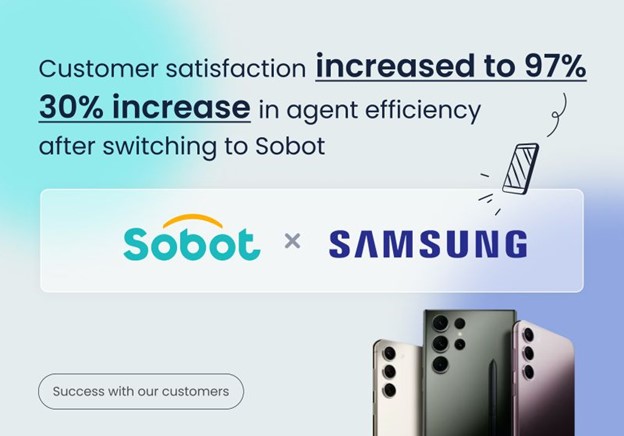
Samsung Electronics is a leading global player in consumer electronic and technology markets. Sobot.io has partnered with Samsung to facilitate its customer service. The company sought to streamline its service delivery to its clients. The company called for a coherent system that would help it interact better with its customers using AI and automation platforms.
Initial Challenges Faced by Samsung Electronics
Platform Fragmentation
The large number of products from smartphones to TVs led to overlapping systems in customer service, hence a disjointed system to deal with customers’ inquiries.
Repetitive Tasks
The company was receiving a lot of repetitive queries. This kept a lot of manpower occupied with the small issues elbows upstream. Inversely, the agents would sometimes not have enough impetus to deal with complex issues.
Lack of Customer Differentiation
The company employs a generalized mode of handling customers because of the large number of its customer base. A lot of specific customers’ needs are therefore inadequately met by the customer service system
Case Study: Enhancing Customer Interactions
Samsung Electronics implemented Sobot.io’s omnichannel platform, which unified all customer service channels onto a single interface. This consolidation allowed agents to seamlessly interact with customers across different messaging platforms without needing to switch between systems.
The AI chatbot provided by Sobot.io was also integrated with Samsung’s ordering system and could provide context-aware responses to requests.
Samsung also employed Sobot’s capabilities to categorize its customers. The features led to the emergence of the VIP client designation, with such customers now being assigned special support teams.
Advantages Samsung Achieved Through Sobot Integration
- Efficiency: Samsung saw a 30% increase in agent efficiency after consolidating its customer service channels.
- Customer Satisfaction: The integration of Sobot’s solutions led to a 97% Customer Satisfaction (CSAT) score, reflecting the positive impact of personalized and streamlined service.
- Sales Conversion: The improved customer interactions contributed to a 15% increase in pre-sales conversion rates.
Future of the Partnership
Samsung and Sobot are planning to continue the cooperation. The companies are considering the implementation of more advanced AI to personalize customer experience even further. The goal is to set new standards regarding predicting customer intention before they are announced and provide support delivered in the most personalized way within the technology industry.
6. Employee development and corporate culture at Samsung
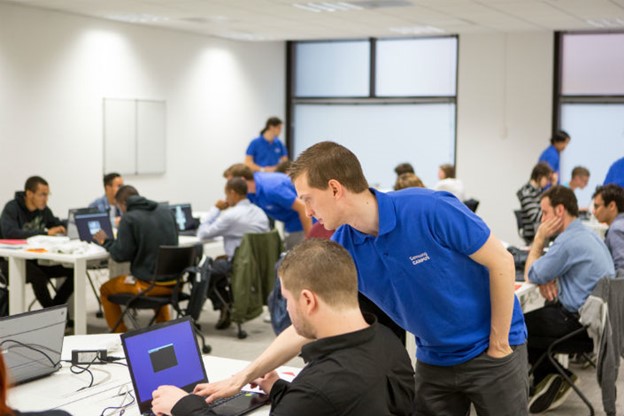
(Image Source: Samsung Newsroom)
Lee’s philosophy, “Our people are our greatest asset,” resonates throughout the organization, fostering a culture of continuous learning and development. The company believes that its success is directly linked to the growth of its employees – this is reflected in a myriad of training programs and career development opportunities.
Focus on Employee Growth: Comprehensive Training Programs
Samsung Global Strategy Group (GSG)
The GSG plays a crucial role in shaping the careers of Samsung’s future leaders. The program equips employees with a deep understanding of international markets and strategic business thinking essential for a successful global company. Problem-solving, leadership, and cross-cultural capabilities are put to the test against the backdrop of real situations encountered by the group. Source.
The UniverSE
Samsung has established The UniverSE, a comprehensive training platform providing over 720 job-related courses in software, R&D, manufacturing, and marketing, among other disciplines. This initiative promotes continuous learning and allows employees to enhance their skills and competencies tailored to their career paths. Source.
Samsung Software Academy for Youth (SSAY)
Samsung also invests heavily in technical training through programs like the Samsung Software Academy for Youth (SSAY). This initiative focuses on nurturing the next generation of software developers by providing intensive coding and software development training. Source.
Workplace Culture: The Values and Principles Defining Samsung’s Work Environment
Samsung is known for its innovation-friendly corporate culture that motivates employees to think unconventionally and consider risky ventures. Diversity is another cornerstone of Samsung’s culture. The company has made significant strides in promoting gender and cultural diversity within its workforce.
The culture of cooperation is deeply integrated into Samsung’s culture as the company has always perceived that developing great things requires the efforts of many.
The company applies this principle to all its levels of operation. For instance, at the management level, Samsung prefers the matrix structure of project management, allowing different units to work together to run a project.
7. Future Trends and Samsung’s Vision
5G Deployment
5G deployment is one of the company’s important steps in technology. Moreover, Samsung is not only a consumer of relevant technologies but also a significant player in developing 5G products and technologies. The sales of 5G smartphones surged from 270 million units in 2020 to 730 million units in 2023, highlighting the rapid adoption of this technology and its impact on the smartphone ecosystem. Source.
Artificial Intelligence
Samsung’s AI strategy it is not confined to mobile devices but expands to household appliances, such as refrigerators which suggest recipes based on the contents inside. Samsung has also invested in, as of the Arab News article, over $22 billion of AI and other new technologies, according to. The point is, therefore, that Samsung is majorly at the forefront of innovation in one of the most important new technologies shaping the current age. Source.
6G Research
Looking ahead, Samsung is already investing in 6G technologies, aiming to lead the global standardization efforts for this next generation of connectivity. The company is exploring advanced technologies like cmWave eXtreme MIMO and native AI integration to prepare for the future. Source
Internet of Things (IoT)
Samsung envisaged the IoT as a unified connected world where all devices would be linked and interact with each other. The company’s SmartThings platform is currently in use by over 63 million people. In 2025, all Samsung products will be IoT-enabled, as the company seeks to dominate the expanding market. Sustainability— as part of the strategic objectives.
Sustainability Initiatives
Samsung is strongly committed to achieving sustainable development. The company also has undertaken to drastically reduce its carbon footprint and become carbon neutral by 2050. Moreover, Samsung is striving to attain a 70% reduction in the release of greenhouse gas emissions from its manufacturing plant by the year 2030. Source
8. Conclusion
In this article, we’ve highlighted Samsung’s strengths as a global technology leader, focusing on its innovation and strong customer service philosophy.
The integration of Sobot’s advanced solutions, including AI-driven chatbots and omnichannel support, has been crucial in helping Samsung sustain its reputation for excellent customer service while adapting to global market demands. We invite readers to consider how Sobot’s solutions can enhance their business operations, both efficiency and customer satisfaction.
(The information in the article is collected from public channels. If the data or pictures are infringing or inaccurate, please contact us to delete or modify it.)
9. Sobot: Revolutionizing Customer Service
One of the industry trailblazers, Sobot is committed to delivering insuperable solutions to streamline customer service’s complexity. Sobot’s mission was born out of the desire to bridge the gap between businesses and their customers successfully.
As the company continued to grow, so did its influence as a global business partner capable of catering to the needs of the worldwide community and adjusting to meet the wants of contemporary organizations.
Technology Innovation
AI-Driven Chatbots
AI chatbots are designed to handle the majority of inquiries, including some of the more specific and irrational ones made by clients, Sobot’s chatbots use the power of AI to streamline the process. Moreover, with the help of the chatbots, which perform most of the inquiries, agents can concentrate on the customers’ needs that might require a more nuanced approach.
Live Chat
The live chat feature provides real-time customer support, enabling businesses to engage with customers instantly. The tool is part of the omnichannel solution and adaptable to the same numerous channels as the system as a whole.
Ticketing Systems
Sobot’s ticketing system helps manage customer inquiries by organizing them into a structured workflow. The ticketing system is highly customizable, allowing businesses to prioritize and categorize tickets based on urgency and importance.
Impact on Businesses
Sobot’s impact on businesses is significant, particularly in the realm of customer satisfaction and operational efficiency. For instance, Samsung Electronics, one of Sobot.io’s key partners, experienced a 97% CSAT and a 15% increase in pre-sales conversion rates after implementing Sobot’s solutions. Source.
Partnerships with Leading Brands
Establishing strong partnership relationships with virtually all luge brands that one can imagine, including Amazon, Walmart, and, of course, Samsung, Sobot.io demonstrated that it could fit into virtually any business context.
For instance, thanks to the partnership, Samsung Electronics company managed to unify the customer service channels and consistently meet the heightened demand for their services and products.
(The information in the article is collected from public channels. If the data or pictures are infringing or inaccurate, please contact us to delete or modify it.)

